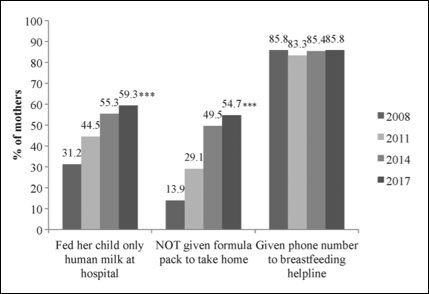Study Correlates Baby-Friendly Care with Improved Breastfeeding Rates
 In a study published in Breastfeeding Medicine, Jung et al. examine breastfeeding outcomes among WIC participants in Los Angeles County (LAC) and their relationships with Baby-Friendly practices.
In a study published in Breastfeeding Medicine, Jung et al. examine breastfeeding outcomes among WIC participants in Los Angeles County (LAC) and their relationships with Baby-Friendly practices.
This study is important because, as is the case with many health outcomes and behaviors, low-income infants experience disproportionately low breastfeeding rates.
The authors analyzed data from the LAC WIC Survey, a triennial cross-sectional survey conducted in English or Spanish through a computer-assisted telephone interviewing system that randomly sampled about 5,000–6,000 WIC families living in LAC, to assess changes in Baby-Friendly hospital practices over time (2008 through 2017), and differences in breastfeeding outcomes by specific Baby-Friendly hospital practices.
Key findings of the study include:
- In LAC, where about two-thirds of all infants are currently served by WIC, the number of Baby-Friendly hospitals in LAC has quickly expanded – from four in 2010 to 38 by the end of 2018.
- An infant had significantly better breastfeeding outcomes when the infant’s mother successfully implemented any of the three Baby-Friendly hospital practices that were evaluated.
- The more Baby-Friendly hospital practices that mothers experienced, the better the infant’s breastfeeding outcomes were.
- Infants born in Baby-Friendly hospitals were significantly more likely to have been exclusively breastfed at the hospital, and less likely to have been given formula when leaving, versus children born in non-Baby-Friendly hospitals.
- The increase in both Baby-Friendly hospitals and engagement of Baby-Friendly hospital practices coincides with significant increases in breastfeeding rates at 1 and 3 months.
“We are encouraged to see even more evidence connecting Baby-Friendly practices to improved breastfeeding outcomes,” said BFUSA CEO Trish MacEnroe. “In this case, it’s particularly heartening because the study explores results for low-income families who tend to have lower breastfeeding rates. We offer the authors our sincere thanks and congratulations for uncovering this important information.”
The full study can be viewed for free for one month at the following link: https://www.liebertpub.com/doi/10.1089/bfm.2019.0004












